Your gift is 100% tax deductible
Key Statistics for Lung Cancer
Most lung cancer statistics include both small cell lung cancer (SCLC) and non-small cell lung cancer (NSCLC). In general, about 13% of all lung cancers are SCLC, and about 87% are NSCLC.
How common is lung cancer?
Lung cancer (both small cell and non-small cell) is the second most common cancer in both men and women in the United States (not counting skin cancer). In men, prostate cancer is more common, while breast cancer is more common in women.
The American Cancer Society’s estimates for lung cancer in the US for 2025 are:
- About 226,650 new cases of lung cancer (110,680 in men and 115,970 in women)
- About 124,730 deaths from lung cancer (64,190 in men and 60,540 in women)
Lung cancer mainly occurs in older people. Most people diagnosed with lung cancer are 65 or older; a very small number of people diagnosed are younger than 45. The average age of people when diagnosed is about 70.
Lung cancer is by far the leading cause of cancer death in the US, accounting for about 1 in 5 of all cancer deaths. Each year, more people die of lung cancer than of colon, breast, and prostate cancers combined.
On a positive note, the number of new lung cancer cases continues to decrease, partly because more people are quitting smoking (or not starting). The number of deaths from lung cancer continues to drop as well, due to fewer people smoking and advances in early detection and treatment.
Lifetime chance of getting lung cancer
Overall, the chance that a man will develop lung cancer in his lifetime is about 1 in 17; for a woman, the risk is about 1 in 18. These numbers include both people who smoke and those who don’t smoke. For people who smoke, the risk is much higher, while for those who don't, the risk is lower.
- Black men are about 12% more likely to develop lung cancer than White men. The rate is about 16% lower in Black women than in White women.
- Black and White women have lower rates than men, but the gap is closing. The lung cancer rate has been dropping among men over the past few decades, but only for about the past decade in women.
- Despite their overall risk of lung cancer being higher, Black men are less likely to develop SCLC than White men.
Statistics on survival in people with lung cancer vary depending on the type of lung cancer, the stage (extent) of the cancer when it is diagnosed, and other factors. For survival statistics, see Lung Cancer Survival Rates.
- Written by
- References

The American Cancer Society medical and editorial content team
Our team is made up of doctors and oncology certified nurses with deep knowledge of cancer care as well as editors and translators with extensive experience in medical writing.
American Cancer Society. Facts & Figures 2025. American Cancer Society. Atlanta, Ga. 2025.
American Cancer Society. Cancer Facts & Figures for African American/Black People 2022-2024.
Howlader N, Noone AM, Krapcho M, Miller D, Brest A, Yu M, Ruhl J, Tatalovich Z, Mariotto A, Lewis DR, Chen HS, Feuer EJ, Cronin KA (eds). SEER Cancer Statistics Review, 1975-2016, National Cancer Institute. Bethesda, MD, https://seer.cancer.gov/csr/1975_2016/, based on November 2018 SEER data submission, posted to the SEER web site, April 2020.
SEER Cancer Stat Facts: Lung and bronchus cancer. National Cancer Institute, Bethesda, MD. https://seer.cancer.gov/statfacts/html/lungb.html. Accessed on Jan 23, 2024.
Last Revised: January 16, 2025
American Cancer Society medical information is copyrighted material. For reprint requests, please see our Content Usage Policy.
American Cancer Society Emails
Sign up to stay up-to-date with news, valuable information, and ways to get involved with the American Cancer Society.



